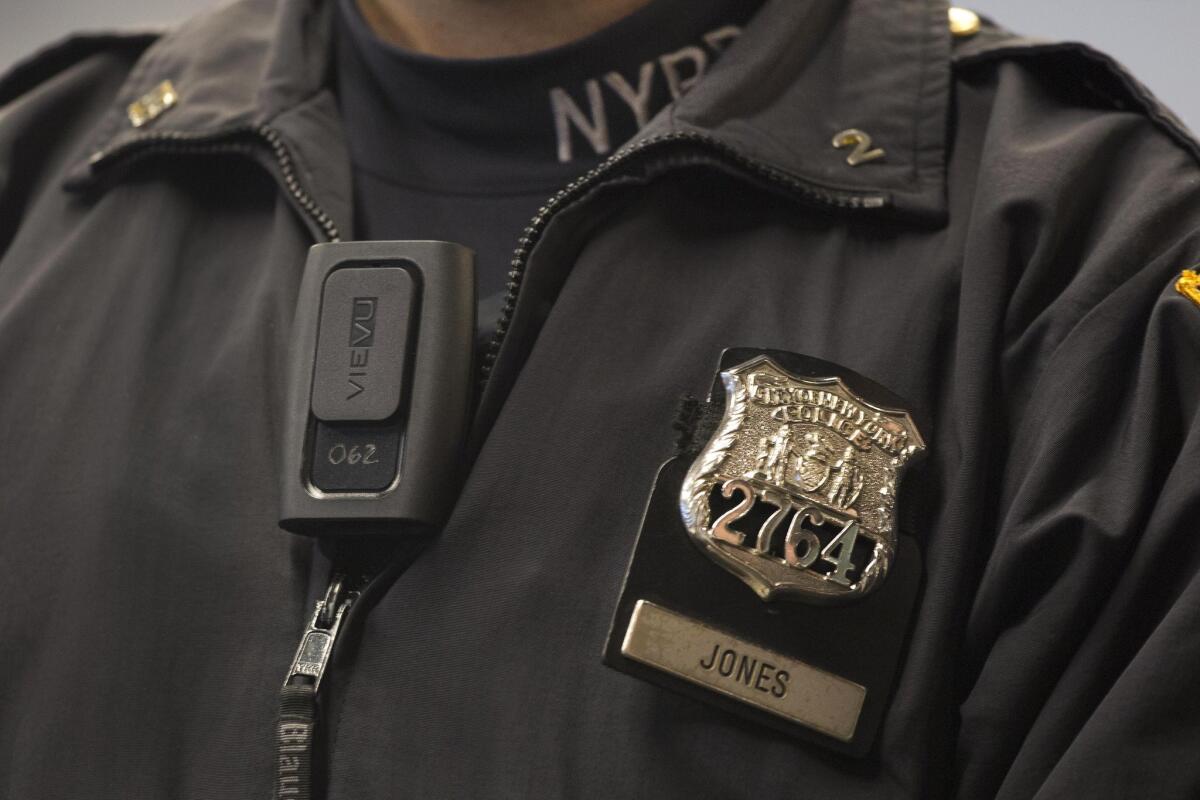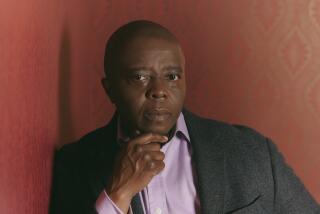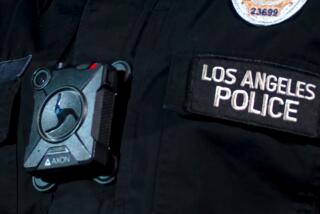Op-Ed: Body cameras aren’t going to fix policing

- Share via
Eric Garner, a 43-year-old unarmed black man, died in an altercation in July with police, in which Officer Daniel Pantaleo had his arm around Garner’s neck in what appeared to be a chokehold as other officers pressed Garner’s body to the ground. A bystander named Ramsey Orta recorded the incident on a cellphone, and the video was presented as evidence to a New York City grand jury.
Outside that courtroom, the public fervently debated the promise of cellphones, body cameras, close-circuit TV and other kinds of recording devices in enhancing police accountability. But inside that courtroom, the jurors debated not issues but evidence, including that video. Ultimately, they decided against indicting Pantaleo.
President Obama has proposed an ambitious plan to earmark more than $250 million to outfit police with body cameras. The “body camera fix” promises to hold police accountable, to quell police militarization and to bridge the gulf between police and private citizens. Or so many Americans believe.
But as the grand jury decision suggests, surveillance is not the same as transparency, and cameras alone cannot fix the twin problems of police accountability and the legitimate use of force.
Cameras are not unbiased observers. Often, they are like witnesses whose hazy memories rarely have the power to subvert powerful narratives that reflect mainstream beliefs about police and criminality. In the court of public opinion, videos may contribute to questioning of the legitimacy of police actions. In the court of law, however, such videos are often alibis, not game-changers. Case in point: A home video of Rodney King’s 1991 beating by police raised public debate about police brutality and accountability, but it failed to lead to a conviction of the four officers in the initial trial.
Social psychologists provide one explanation for this. In a landmark 1980 study, Andrew Sagar and Janet Schofield asked white and black sixth-grade students to evaluate pictures of ambiguous aggression. It was unclear, for example, whether the student pictured was playfully jostling or threateningly pushing another child. The researchers found that all students — black and white — were more likely to view actions as mean and threatening when performed by a black rather than a white student.
Subsequent research has corroborated these findings in adults. Where video is ambiguous (which is more common than often assumed), the best scholarship suggests that it will buttress police accounts rather than undercut them.
The fact that police already have cameras in their cars — the “dash cam” — raises questions about the utility of providing police with even more capacity for surveillance. These cameras are everywhere, but they can be turned off; video can be lost, erased or corrupted; or departments can simply refuse to release video. The police police themselves.
Outfitting law enforcement with body cameras may also backfire on those it’s meant to protect: people in poor communities, people of color, people in high-crime areas. Privacy may well be a thing of the past, but the erosion of privacy is not distributed equally across society.
True, cameras may reveal what organizations such as the ACLU and the Cato Institute have shown: Police disproportionately “stop and frisk” racial minorities, particularly young men of color; police make good on the saying that “the only bad arrest is no arrest” in domestic violence disputes, leading many women to avoid calling the police altogether; and no-knock raids often go wrong, injuring or killing innocent people.
However, body cameras would also expand police databases, linking police reports, fingerprints and DNA to video that disproportionately features people of color. When police say that they don’t racially profile but stop people “based on experience,” they will now have at their disposal thousands, if not millions, of hours of video to release — probably still at their discretion — to demonstrate their claims with the “truth” of audiovisual evidence.
Finally, the availability of police video may well provide an opening for increased regulation of private civilians’ ability to record and disseminate videos of police actions, a long-contentious issue for law enforcement. Why should civilians record police when police can do it themselves? Illinois just days ago moved to make it a felony to record a police officer, even as many officers there have embraced the idea of body cameras for themselves in recent years.
Although body cameras, under the right conditions, could enhance police accountability, we must be cautious about treating them as the be-all, end-all of police reform. On its own, a camera on every officer can never do the hard work of addressing problems of police accountability and use of force. Police cameras alone will not translate into greater accountability as long as departments rely on internal oversight. Cameras won’t stop police militarization as long as police agencies apply military tactics to public law enforcement. And cameras by themselves won’t repair deep-seated distrust between police and communities of color as long as officers are still trained and rewarded for tactics that, whether unintentional or not, disproportionately target racial minorities.
The conversation must also include broader reforms that seek to enhance community-police relations that create direct ties of accountability between officers and the people they police, involve community members in oversight and disentangle the military mindset from public law enforcement. And as we debate these solutions, we should consider how they might harm as well as help poor communities of color that are already the targets of intense police surveillance.
There are no quick fixes. For now, we already have the cameras best positioned to enhance police accountability: those in the hands of bystanders such as Ramsey Orta. If they alone aren’t sufficient, how can we expect police body cameras to do better?
Jennifer Dawn Carlson, an American sociologist who teaches at the University of Toronto, writes about policing, gun policy and gun culture. Her book “Citizen-Protectors: The Everyday Politics of Guns in an Age of Decline” comes out in May.Follow the Opinion section on Twitter @latimesopinion
More to Read
Sign up for Essential California
The most important California stories and recommendations in your inbox every morning.
You may occasionally receive promotional content from the Los Angeles Times.










